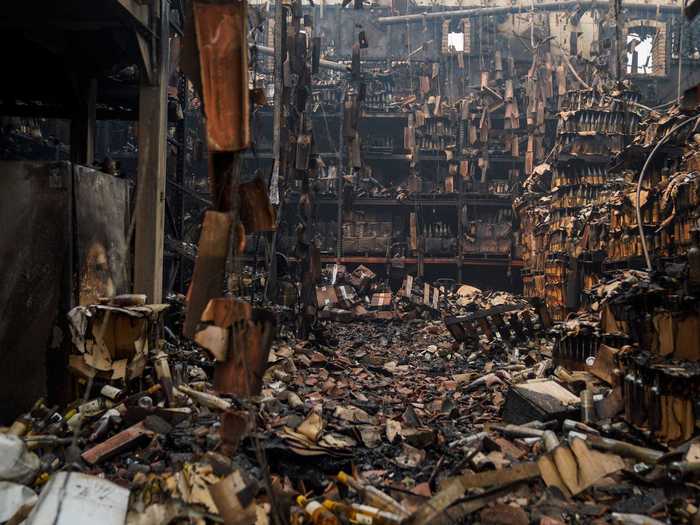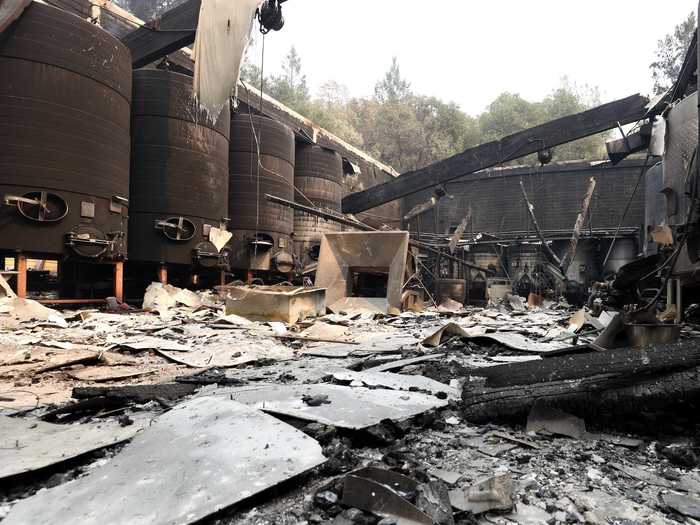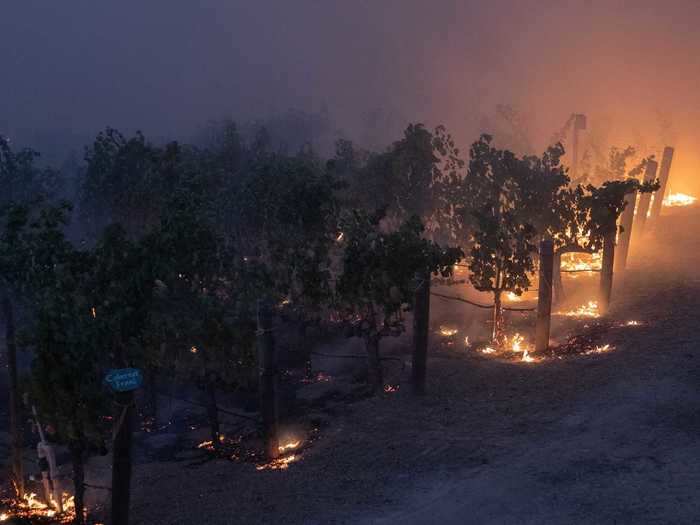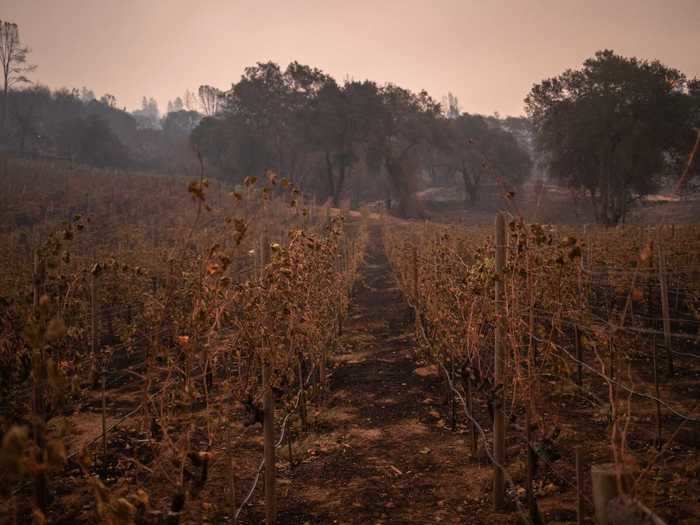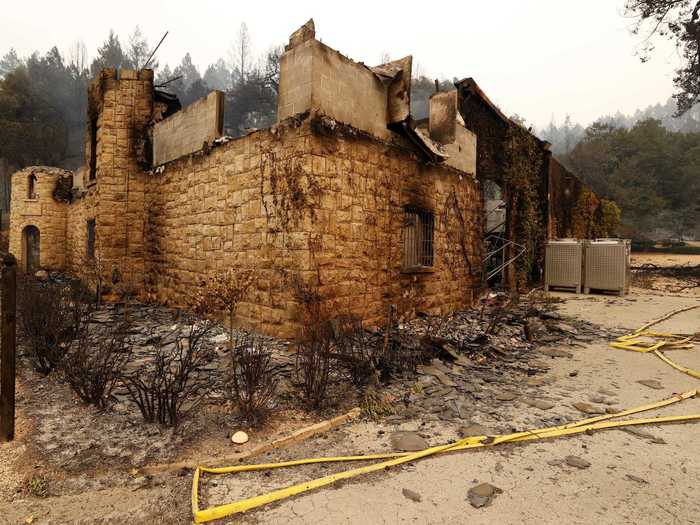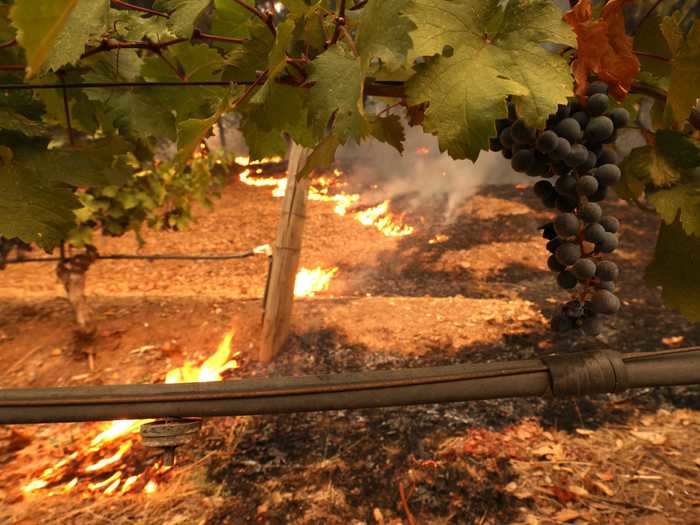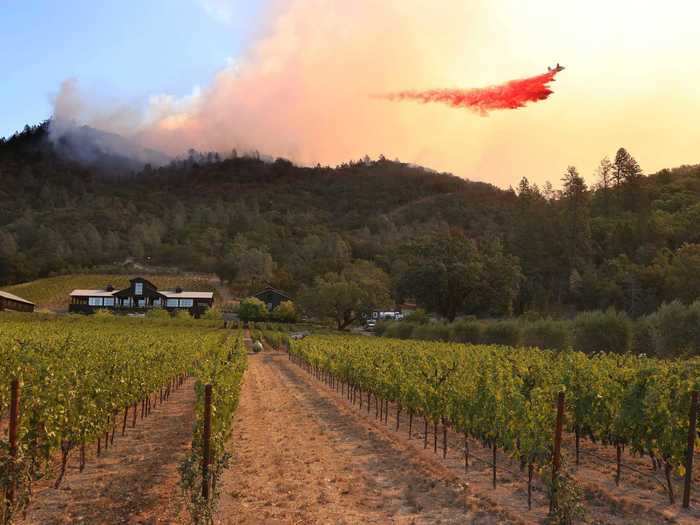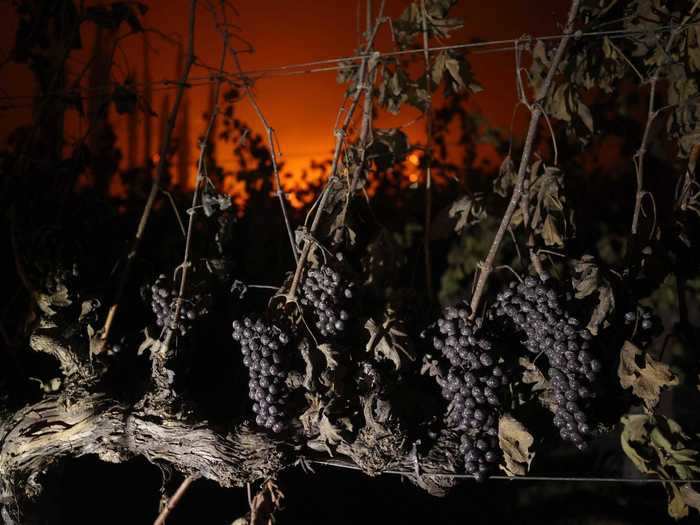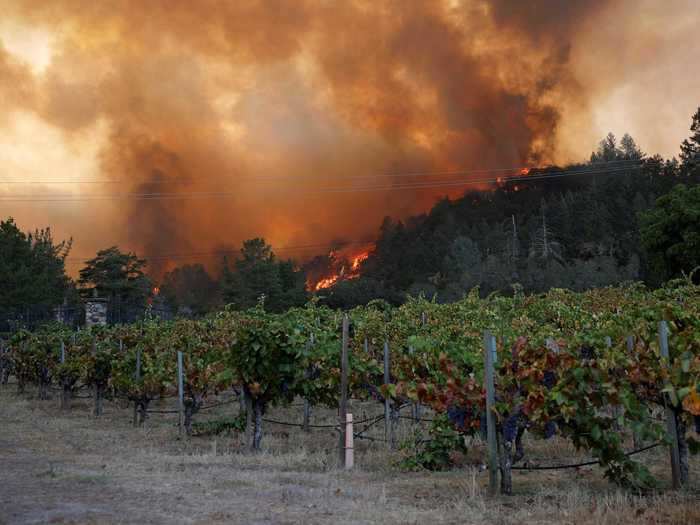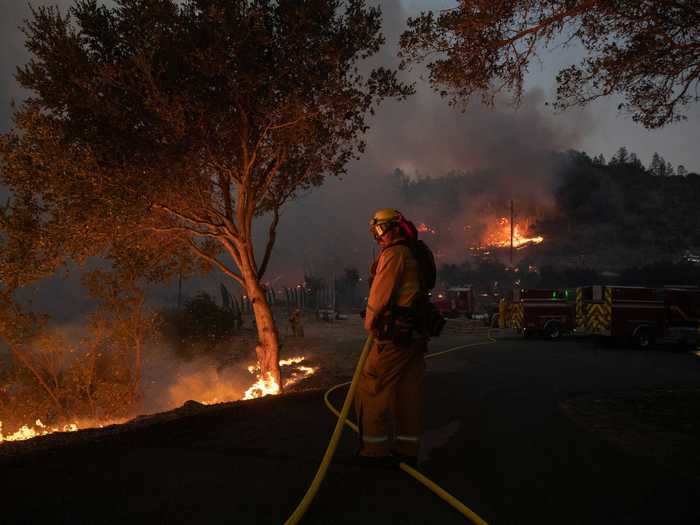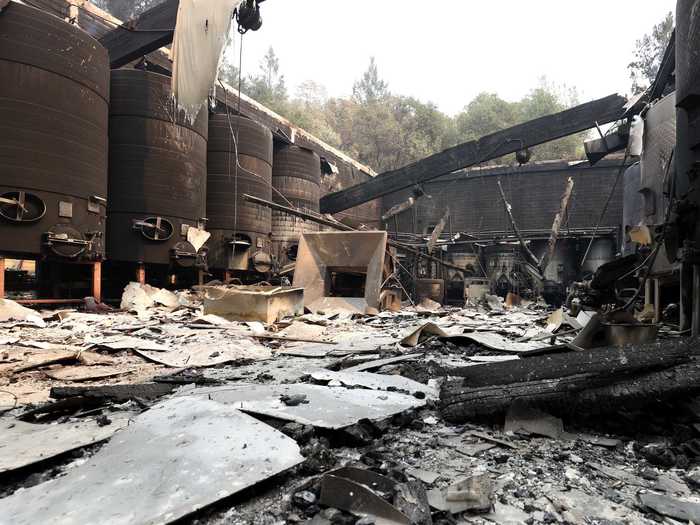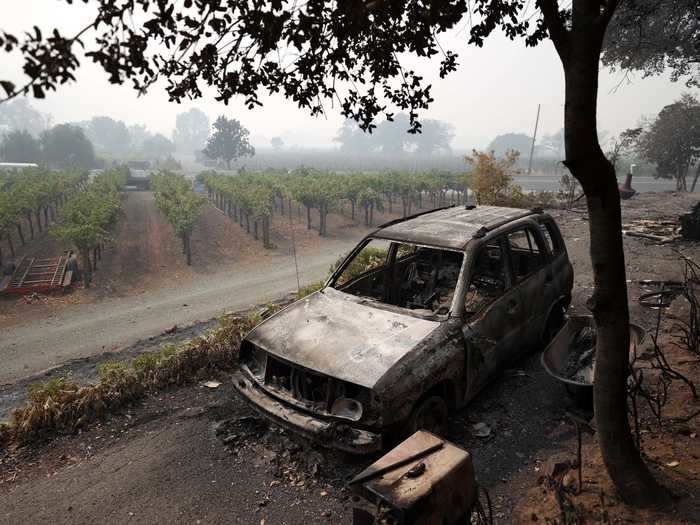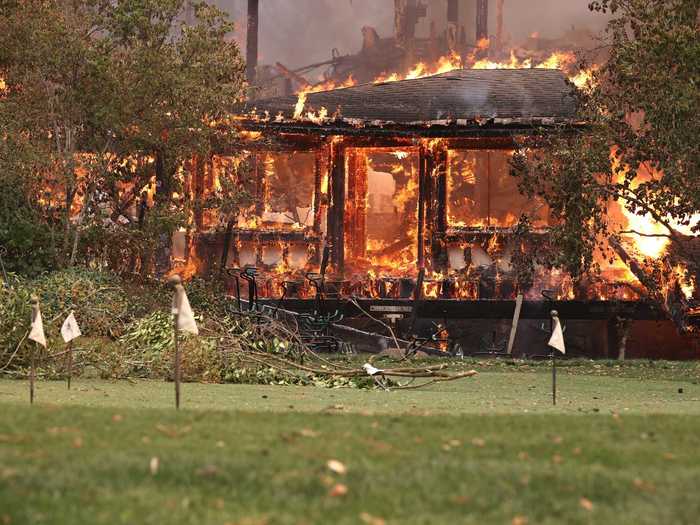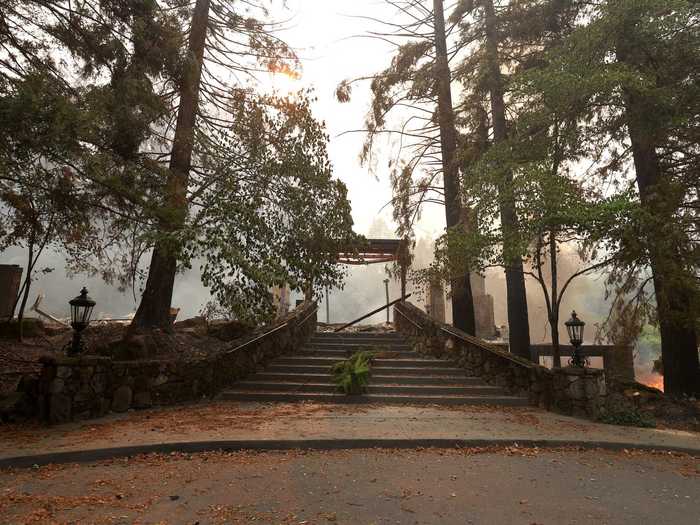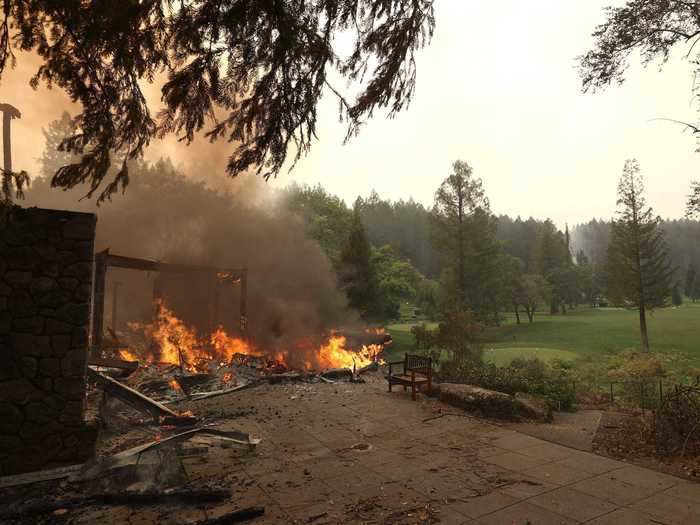Residents look on as the Glass Fire burns through the area on September 27, 2020 in Calistoga, California.Justin Sullivan/Getty Images
- The Glass Incident Fire sparked early Sunday morning, and it has ravaged 48,440 acres of Napa County and surrounding areas so far.
- Many of these acres included warehouses and vineyards of the county's many wineries.
- Smoke from the fire taints grapes too, making them cheap and unusable.
- The wine industry in Napa and surrounding areas make more than $10 billion a year in sales and tourism.
- Take a look at the Glass Incident Fire's devastating impact.
The Glass Incident Fire began raging through Northern California early Sunday morning. Three days later, at least 19 wineries and have been affected, from burnt buildings and warehouses to torched and smoked vineyards.
Fire damaged grapevines sit in front of the destroyed Chateau Boswell Winery after the Glass Incident Fire moved through the area on September 28, 2020 in St. Helena, California.
Justin Sullivan/Getty Images
Castello di Amorosa, a winery in Napa County, sustained extensive damages when the fires ravaged a warehouse holding 120,000 bottles of wine worth about $5 million.
The farmhouse at Castello di Amorosa, decimated by the Glass Fire in Napa County on Tuesday, Sept. 29, 2020, in Calistoga, CA.
Kent Nishimura / Los Angeles Times via Getty Images
The wine industry in California's Napa and Sonoma counties make more than $10 billion a year, Robert Eyler, a professor of economics at Sonoma State University, told The Atlantic in 2017.
Damaged fermentation tanks are seen at Fairwinds Estate Winery that was destroyed by the Glass Fire on September 29, 2020 in Calistoga, California.
Justin Sullivan/Getty Images
The economic impacts from the disaster are not yet known, but 3.7 million acres of California have burned so far this year. In an average year, less than 350,000 acres of the state burns, per Insider.
A vineyard burns from the encroaching Glass Fire in Deer Park, California, U.S. September 27, 2020.
REUTERS/Adrees Latif
The Glass Incident Fire is 2% contained and has consumed 48,440 acres of land in Northern California's wine country.
A vineyard is left burned in the aftermath of the Glass Fire in Deer Park, California, U.S. September 28, 2020.
REUTERS/Adrees Latif
Many buildings and warehouses were destroyed, including the Chateau Boswell Winery.
A general view of the remains of the Chateau Boswell Winery after the Glass Fire came through, in Saint Helena, California, U.S., September 28, 2020.
REUTERS/Fred Greaves
Vineyards that have not been burned also face an economic risk because grapes tainted by smoke can result in ashy-tasting wine.
The Glass Fire approaches grape vines at a vineyard on September 27, 2020 in Napa, California.
Justin Sullivan/Getty Images
With too much exposure to smoke, the grapes are unusable, Bloomberg reported.
A firefighting aircraft drops retardant ahead of the Glass Fire at Davis Estates winery on September 27, 2020 in Calistoga, California.
Justin Sullivan/Getty Images
Mia Van de Water, a master sommelier at Cote Korean Steakhouse in New York, previously told Business Insider that wine exposed to smoke is often blended with other wine to dilute the taste, then sold for cheaper than it would normally cost.
Grapes hang from a vine at Chateau Boswell Winery burns as the Glass Fire moves through the area on September 27, 2020, in St. Helena, California.
Justin Sullivan/Getty Images
To save the harvest from smoke and fire, some wineries will pick the grapes before they are ripe.
Flames are seen on a hill above a vineyard on Crystal Springs Road during the Glass Fire in Deer Park, California, U.S. September 27, 2020.
REUTERS/Stephen Lam
The alternative to this would be to file an insurance claim after smoke or fire destroys the grapes.
Firefighters protect a residence as the Glass Fire encroaches onto a vineyard in Deer Park, California, U.S. September 27, 2020.
REUTERS/Adrees Latif
But most insurance companies compensate for losses based on the average value of grapes, which could be cheaper than the compromised grapes. For example, the average value of grapes was $800 per ton in the state of California in 2017, per The Atlantic.
Damaged fermentation tanks are seen at Fairwinds Estate Winery that was destroyed by the Glass Fire on September 29, 2020 in Calistoga, California.
Justin Sullivan/Getty Images
But many grapes are far more valuable, ranging from $100 to more than $7,000 per ton in the last two years, according to a report published by Vintroux, a real estate firm in wine country.
A car that was destroyed by the Glass Fire sits next to a vineyard on September 29, 2020 in Calistoga, California.
Justin Sullivan/Getty Images
Aside from wineries, resorts and restaurants in the area are being consumed by flames. Napa Valley's three-Michelin-star Restaurant at Meadowood burned down on Monday morning.
The main building and restaurant at Meadowood Napa Valley luxury resort burns after the Glass Incident Fire moved through the area on September 28, 2020 in St. Helena, California.
Justin Sullivan/Getty Images
The head chef, Christopher Kostow, previously told Insider that the restaurant has plans to rebuild.
A stairway leads to the destroyed main building and restaurant at Meadowood Napa Valley luxury resort after the Glass Incident Fire moved through the area on September 28, 2020 in St. Helena, California.
Justin Sullivan/Getty Images
"Napa Valley and California have seen their share of challenges and have always demonstrated a resiliency that others emulate," he said. "The important thing right now is to protect lives and property, and address the bigger issue of climate change."
The main building and restaurant at Meadowood Napa Valley luxury resort burns after the Glass Incident Fire moved through the area on September 28, 2020, in St. Helena, California.
Justin Sullivan/Getty Images


